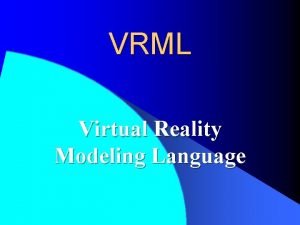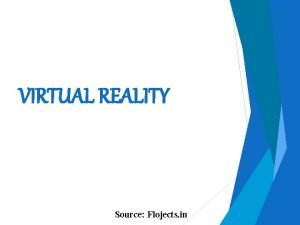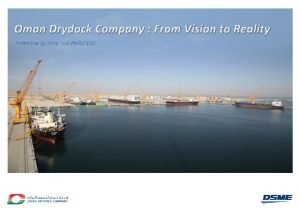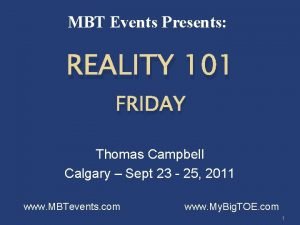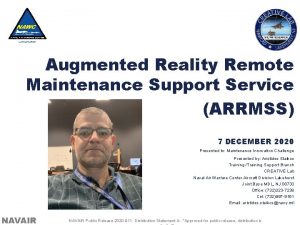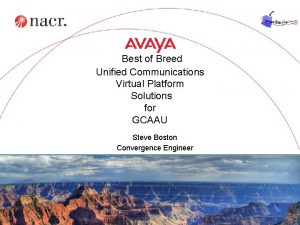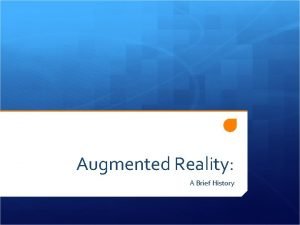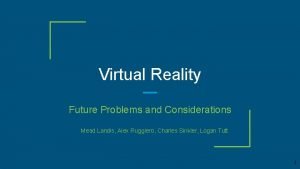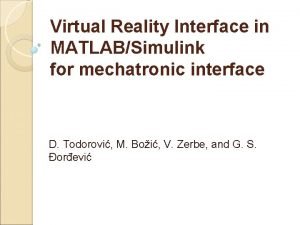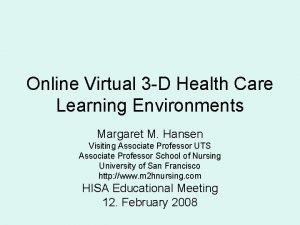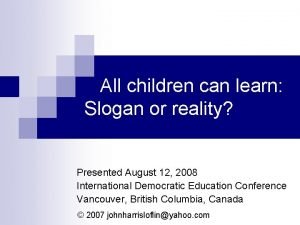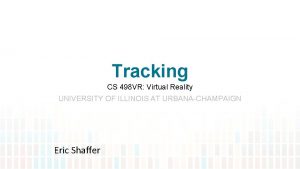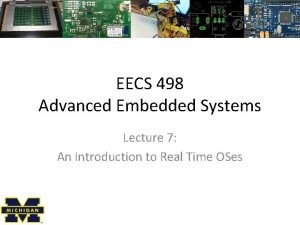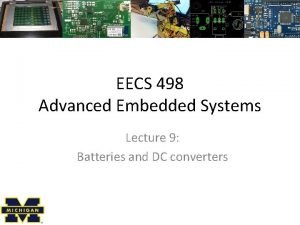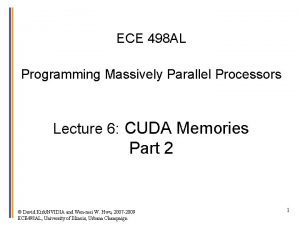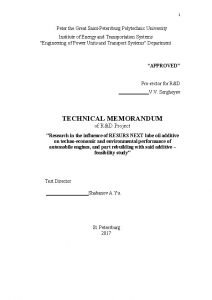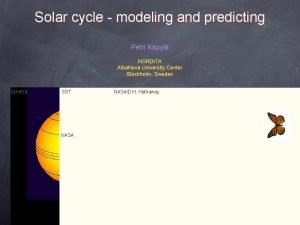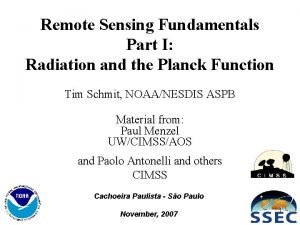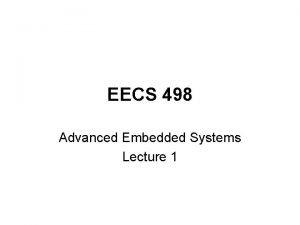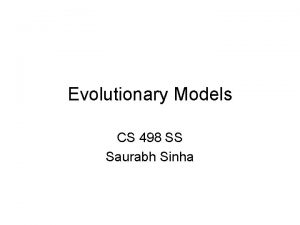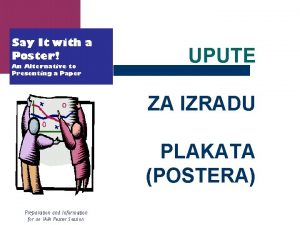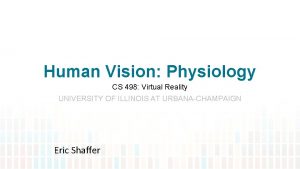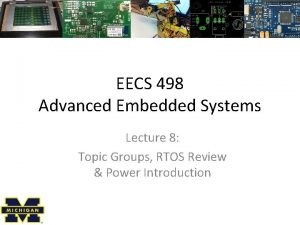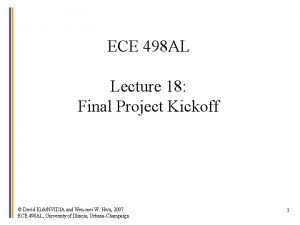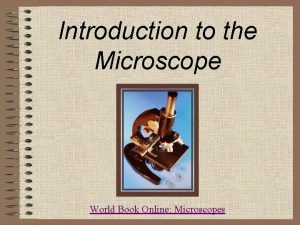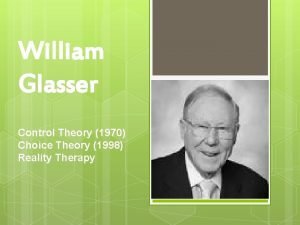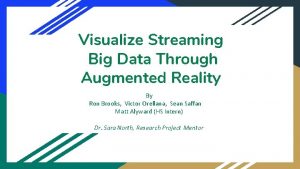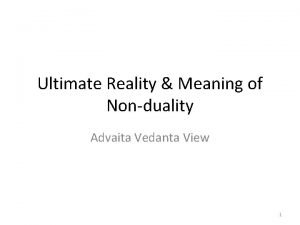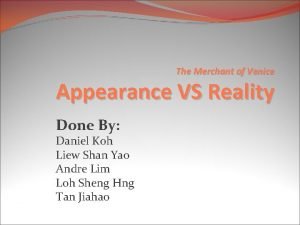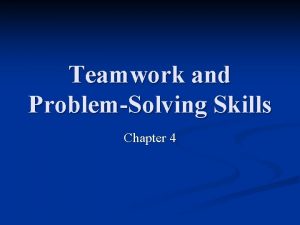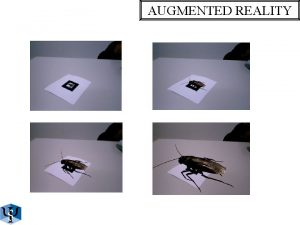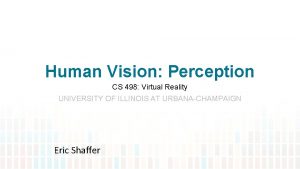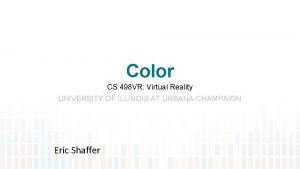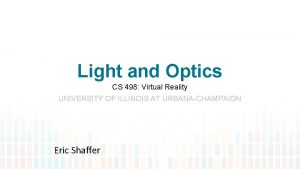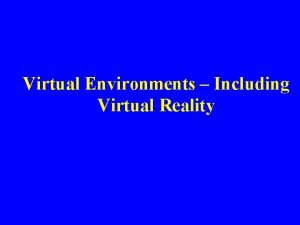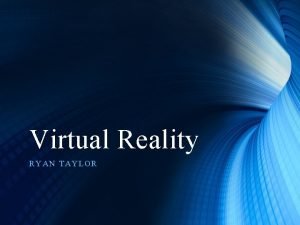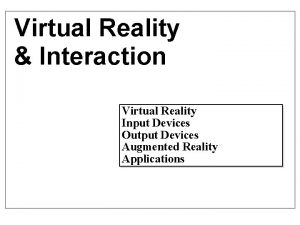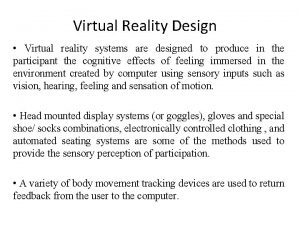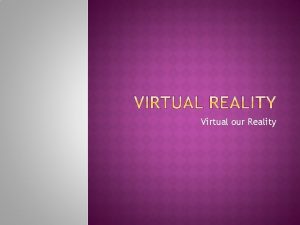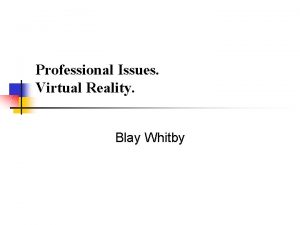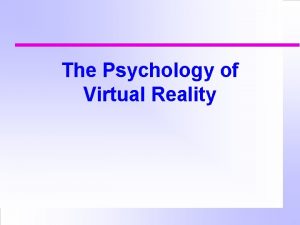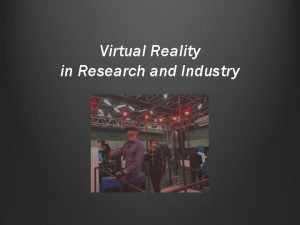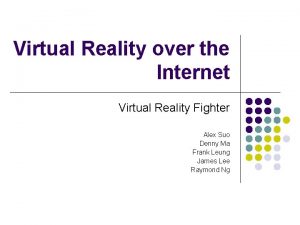Tracking CS 498 VR Virtual Reality UNIVERSITY OF












































- Slides: 44

Tracking CS 498 VR: Virtual Reality UNIVERSITY OF ILLINOIS AT URBANA-CHAMPAIGN Eric Shaffer

Tracking Systems in VR • Keeping track of motion in the physical world is a crucial part of any VR system. • Tracking was one of the largest obstacles to bringing VR headsets into consumer electronics, • Highly accurate tracking methods have been mostly enabled by commodity hardware components • inertial measurement units (IMUs) • Cameras • These have plummeted in size and cost due to the smartphone industry

Things We Would Like to Track What do we want to track? (Think of rigid bodies) ● Head wearing HMD ● ● ● Eyes Palms of hands Fingers Entire body Interactable objects - controller, coffee cup, desk. . . Other people in the space

Tracking Rigid Bodies ● ● We want to track 3 D position and orientation over time How can we store this information?

Tracking Rigid Bodies ● Google Cardboard Gear VR Oculus HTC Vive

Gyroscope Device that measures angular velocity Measurement is an approximation to true angular velocity Calibration error ● ● biggest reason for difference between true and measured values Biggest difference between high quality IMU ($1000+) …and cheap IMU ($1)

Drift Error

Four Problems to Solve in Tracking Calibration: adjust sensor values to remove error Integration: orientation is estimated by integrating discrete measurements Registration: initial orientation must be determined Drift error: error grows over time and must be removed

Calibration is the process of configuring an instrument to provide a result for a sample within an acceptable range.

Integration ● Rift gyroscope samples every 1 ms yielding a 1000 Hz sampling rate

Registration Need to determine a initial forward direction ● Can be whatever direction HMD is facing when booted …this can cause problems when switching HMD to a new user …can add ability to rest forward to current facing direction ● Can be a fixed direction in physical world e. g. towards Rift camera In 3 D, pitch and roll components align with gravity ● World shouldn’t tilt…

Drift Correction ●

Drift Correction Considerations ● The gain could be selected “optimally” by employing a Kalman filter; however, the optimality only holds if we have a linear stochastic system, which is not the case in human body tracking.

3 D Orientation IMUs are now microscopic MEMS circuits ● Gyroscope: measure angular velocity around 3 orthogonal axes ● Accelerometer: measure linear acceleration along 3 axes ● Magnetometer: Measure magnetic field strength along 3 orthogonal axes

Calibration in 3 D MEMS elements may not be orthogonal…need to account for that error as well What would matrix look like if we were assured of orthogonality? Can fill out matrix using samples and linear least squares as before. Works for gyroscope and accelerometers…magnetometers more complicated May need to use different calibrations at different temperatures

Integration in 3 D We have We can express the change in orientation as a quaternion Axis: Angle: Yields quaternion: Orientation update becomes:

Drift Error in 3 D Drift error is a quaternion What is this value if there is no error? Note that applying the drift error to the estimate yields We will decompose the error into 2 parts: ● Tilt Error: The pitch and roll components ● Yaw Error: …the yaw component

Tilt Error We will detect and correct this using an “up sensor” ● In practice, this is the accelerometer measuring the effect of gravity Up vector reported in “body coordinates” ● e. g. up starts at (0, 1, 0)…if body rolls 90 degrees it becomes (0, 0, 1) Transform it into world coordinates by rotating by orientation quaternion When transformed we should get (0, 1, 0)…. . Head Tracking for the Oculus Rift, IEEE International Conference on Robotics and Automation 2014, S. La. Valle, A. Yershova, M. Katsev, M. Antonov

Correcting Tilt Error Tilt error makes the transformed up vector not align with (0, 1, 0) We can project the transformed vector onto the xz plane. Tilt axis is then We can rotate around the tilt axis to align the up vector and y axis. . . tilt error is

Correcting Tilt Error in Practice Accelerometer reports all acceleration …only trust it when upward magnitude is close to 9. 8 m 2 ? In practice, use complex heuristics ● Evaluating other sensor data ● Rate of change of accelerometer

Yaw Error Correct using a “compass” that generates a vector ● In xz plane ● Pointing “north” Same correction mechanism as tilt ● Vector is reported in body coordinates ● Transform it to world coordinates ● Measure deviation from (0, 0, -1)…or whatever world “north” is…

Correcting Yaw Error in Practice Use magnetometer to measure a magnetic field vector Vector doesn’t lie in horizontal plane…has an inclination angle Can project to xz plane Projected vector has declination angle deviating from true north We can ignore this…why? Finally, need to compensate for field distorting elements (iron) in HMD

Correcting Yaw Error in Practice Field vector is close to vertical in Finland… Still can have problems… If magnetic field vector is too close to vertical it’s useless Some buildings distort the vector in a 0 magnitude vector…that’s bad too

Filtering Can filter like before…but on quaternions… We obtain the drift quaternion by multiplying tilt and yaw error quaternion Before we used subtraction…now we multiply by an inverse quaternion Think of it as stepping in the direction of the correction by some small amount Could also keep tilt and yaw separate and use separate gains

Inside-Out Tracking

Setting the Viewpoint ● How does prediction work? Why is it used?

Debugging Tip ● ● Connecting viewpoint to tracked orientation often done incorrectly Can debug by testing rotations around 3 canonical axes + world moves correctly - world moves opposite of correctly

A Head Model ● Virtual head height should be the same as in real world ○ ● ● Unless the experience is meant to be different (e. g. mouseworld) As head rotates, eyes change positions Let h and p be offsets to an eye measured from center of head rotation Can apply head transformation before the lookat transform h and p should then be formed to move world objects This model was used in Samsung Gear VR…. better solutions can be implemented using more sensors

Tracking Position and Orientation Now we will discuss tracking all 6 DOFs for a moving rigid body We call the position + orientation the pose Being able to track all 6 DOFs means we don’t need a head model

Integrate the Accelerometer? We could subtract off acceleration due to gravity and find body acceleration… What do we need to estimate position? How does that contrast with using a gyroscope to compute orientation? What is effect on the error? Can the IMU sensors be used to correct positional drift error?

Integrate the Accelerometer? What do we need to estimate position? Integrate twice How does that contrast with using a gyroscope to compute orientation? Only a single integrating is necessary to find orientation from angular velocity What is effect on the error? Orientation error is linear in time. Positional would be quadratic in time. Can the IMU sensors be used to correct positional drift error? No…can’t detect even constant velocity

Active Tracking Another approach is to create a signal to be sensed Many approaches have been tried ● Infrared ● Ultrasound ● Electromagnetic

Trilateration ● ● Consider something like ultrasound Emitter is a speaker and detector is a microphone Speaker emits at known time intervals… Time of Flight (time to detection) enables computation of distance Three emitters allow unique determination of location…

Sound and EM…and Visibility Both kinds of systems have been problematic ● Sound reflects off objects in the rooms leading multiple detections ● Environment can warp EM fields and thus warp detected trajectories Visibility approaches have been more robust Camera can be used to track features Oculus Rift system tracks infrared LEDs on the HMD

A Quick Guide to Features ● ● Natural Features: Automatically discovered and labeled Artificial Features: Engineered and placed in scene with assigned labels Passive Features: Do not emit energy…can reflect energy (i. e. light) Active Features: Emit light

Perspective-n-Point Problem (Pn. P) ● ● ● Using n-points on an object in an image, compute the pose matrix Trb Each observed point (i, j) in image coordinates eliminates 2 DOFs For 3 points (i. e. P 3 P) 0 DOFs remain but solution is not unique P 6 P required for unique solution More than 6 points generally used to make solution robust to error

Camera-Based Implementation We can either ● Have a fixed camera and moving features (Rift) ● Have a moving camera and fixed features

Camera Calibration ●

Laser-Based-Implementation ● ● ● Lighthouse HTC Vive tracking is an example Lighthouse has spinning drum emitting vertical and horizontal IR light Photodiodes on HMD detect IR light

Laser-Based-Implementation ● ● ● Horizontal light determines pixel column of feature coordinate Vertical light determines pixel row of feature coordinates Multiple base stations needed to compute distance from feature to station

Filtering IMU frequency is much higher than camera usually…so it is useful to use it Orientation can be computed using camera and IMU together to reduce error ● Camera optical axis can be used to estimate yaw error (replacing magnetometer) ● If camera tilt is known, it can be used to provide tilt error estimation (replacing accelerometer)

Integrating the Accelerometer ●

Correcting the Estimated Velocity and Position ●

Oculus Quest
 Virtual reality modeling language tutorial
Virtual reality modeling language tutorial Virtual reality input and output devices
Virtual reality input and output devices Virtual reality company in oman
Virtual reality company in oman Tom campbell virtual reality
Tom campbell virtual reality Virtual reality business cards
Virtual reality business cards What does vrml stand for
What does vrml stand for Mobile virtual reality service
Mobile virtual reality service Virtual reality remote maintenance
Virtual reality remote maintenance Virtual reality unified communications
Virtual reality unified communications Ivan sutherland head mounted display
Ivan sutherland head mounted display Conclusion on virtual reality
Conclusion on virtual reality Conclusion of virtual reality
Conclusion of virtual reality Virtual reality joke
Virtual reality joke Pros and cons of virtual reality in healthcare
Pros and cons of virtual reality in healthcare All children can learn slogan
All children can learn slogan Cs 498 vr
Cs 498 vr Eecs 498
Eecs 498 Cs 498 vr
Cs 498 vr Embedded systems
Embedded systems Quem pode o mais pode o menos direito administrativo
Quem pode o mais pode o menos direito administrativo Cs 498 vr
Cs 498 vr Ece 498
Ece 498 +1 (432) 498-0251
+1 (432) 498-0251 Kpyl
Kpyl 498
498 Eecs 498
Eecs 498 Cs 498 cloud computing applications
Cs 498 cloud computing applications Mala tiskana slova
Mala tiskana slova Cs498 dl github
Cs498 dl github Eecs 498
Eecs 498 Ece 498
Ece 498 Has virtual functions and accessible non-virtual destructor
Has virtual functions and accessible non-virtual destructor Virtual university mba
Virtual university mba Leeds virtual slides
Leeds virtual slides Virtual university examination software
Virtual university examination software Virtual university of tunis hours
Virtual university of tunis hours National virtual university
National virtual university 1886 modern compound light microscope
1886 modern compound light microscope 詹景裕
詹景裕 Control theory william glasser
Control theory william glasser Augmented reality big data
Augmented reality big data Freudian fixation
Freudian fixation Advaita philosophy meaning
Advaita philosophy meaning Appearance vs reality in the merchant of venice
Appearance vs reality in the merchant of venice Teamwork and problem solving skills chapter 4 quiz
Teamwork and problem solving skills chapter 4 quiz
